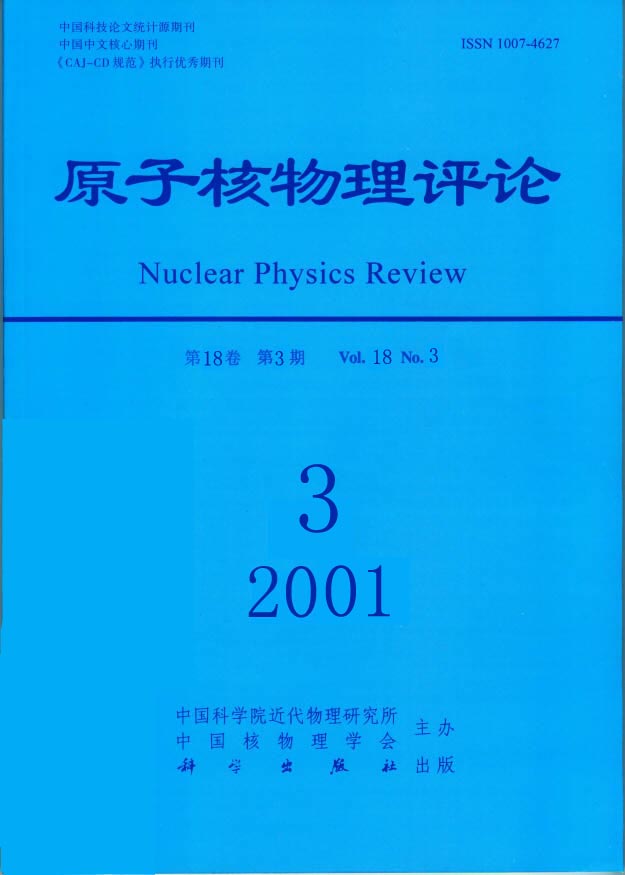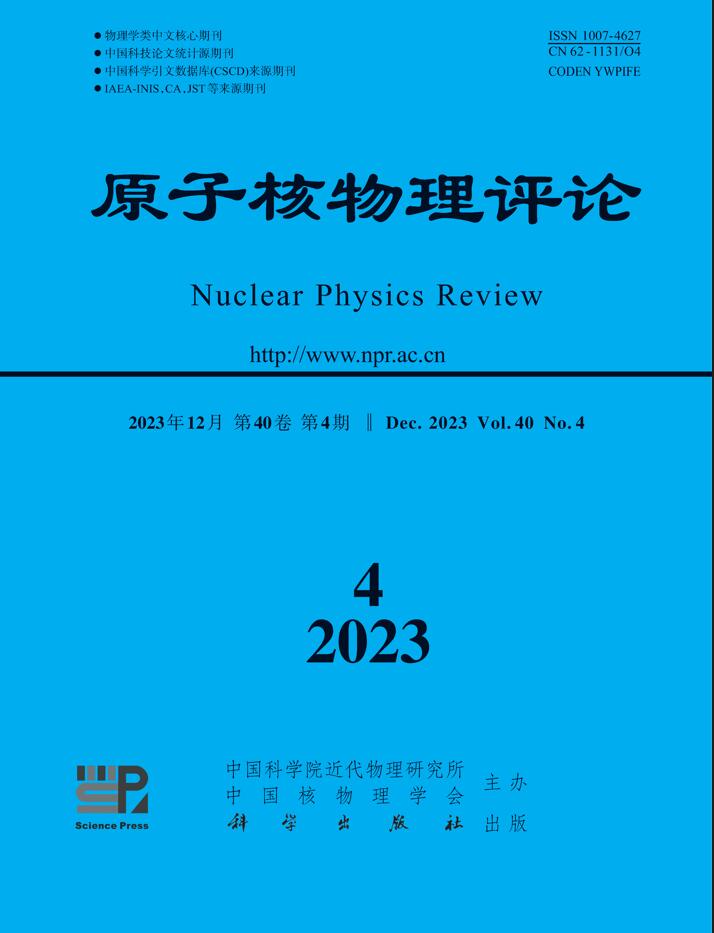2001 Vol. 18, No. 3

Display Method:
2001, 18(3): 129-137.
doi: 10.11804/NuclPhysRev.18.03.129
Abstract:
We try to highlight some of the key issues regarding the interactions between strange hadron and nucleon, which relate to the kinematics and dynamics mechanism, meson exchange model and quark model. Starting from a brief introduction on the main research goals, we focus on the status of experimental and theoretical investigations of kaon nucleon and hyperon nucleon interactions, which may be considered to be a necessary basis for the studies of nuclear physics with strangeness.
We try to highlight some of the key issues regarding the interactions between strange hadron and nucleon, which relate to the kinematics and dynamics mechanism, meson exchange model and quark model. Starting from a brief introduction on the main research goals, we focus on the status of experimental and theoretical investigations of kaon nucleon and hyperon nucleon interactions, which may be considered to be a necessary basis for the studies of nuclear physics with strangeness.
2001, 18(3): 138-142.
doi: 10.11804/NuclPhysRev.18.03.138
Abstract:
A search for γ ray bursts at 3 TeV energy region was done by using the data of Tibet HD air shower array, which was obtained in the period of Febuary 1997-June 1998. About 2.5×10 9 EAS events were analysed to search for the shower clusters appearing in a fixed time intervial and small sky bin. An equal zenith angle method is used to estimate the background and three different time intervals(Δ t =1, 10, 100 s) were adopted in the research. A part of clusters show excess over the...
A search for γ ray bursts at 3 TeV energy region was done by using the data of Tibet HD air shower array, which was obtained in the period of Febuary 1997-June 1998. About 2.5×10 9 EAS events were analysed to search for the shower clusters appearing in a fixed time intervial and small sky bin. An equal zenith angle method is used to estimate the background and three different time intervals(Δ t =1, 10, 100 s) were adopted in the research. A part of clusters show excess over the...
Two-body Correlation Contributions in Halo Nuclei in Relativistic Density Dependent Hartree Approach
2001, 18(3): 143-146.
doi: 10.11804/NuclPhysRev.18.03.143
Abstract:
The basic properties of halo nuclei are investigated in the relativistic density dependent Hartree approach, where the correlation effects among halo particles are crucial for the description of the halo property. Adapting only one free parameter, we have calculated the separation energies and mass density distributions of halo nuclei 11 Li, 11 Be and 19 C and they are in good agreement with the experimental data.
The basic properties of halo nuclei are investigated in the relativistic density dependent Hartree approach, where the correlation effects among halo particles are crucial for the description of the halo property. Adapting only one free parameter, we have calculated the separation energies and mass density distributions of halo nuclei 11 Li, 11 Be and 19 C and they are in good agreement with the experimental data.
2001, 18(3): 147-151.
doi: 10.11804/NuclPhysRev.18.03.147
Abstract:
The explosive nucleosynthesis in the astrophysical environment and its close link to nuclear structure are discussed. The low lying octupole bands for neutron rich nucleus 148 Ba far from the stability line have been calculated by the reflection asymmetric shell model and the results are in good agreement with the experimental data, presenting the capability of the model for calculations of the low lying states of unstable nuclei as well as the foreground of application in nuclear astrophysics.
The explosive nucleosynthesis in the astrophysical environment and its close link to nuclear structure are discussed. The low lying octupole bands for neutron rich nucleus 148 Ba far from the stability line have been calculated by the reflection asymmetric shell model and the results are in good agreement with the experimental data, presenting the capability of the model for calculations of the low lying states of unstable nuclei as well as the foreground of application in nuclear astrophysics.
2001, 18(3): 152-155.
doi: 10.11804/NuclPhysRev.18.03.152
Abstract:
Proton emission is a very important property of the extreme proton rich nuclei. It is introduced that the proton emission from a spherical nucleus can be well described by WKB method, while that from a deformed nucleus must be described by means of solving coupled channel Schrdinger equations. The investigation of the proton emitters 140Ho, 141Ho offered information about the structure of unbound Nilsson orbitals.
Proton emission is a very important property of the extreme proton rich nuclei. It is introduced that the proton emission from a spherical nucleus can be well described by WKB method, while that from a deformed nucleus must be described by means of solving coupled channel Schrdinger equations. The investigation of the proton emitters 140Ho, 141Ho offered information about the structure of unbound Nilsson orbitals.
2001, 18(3): 156-159.
doi: 10.11804/NuclPhysRev.18.03.156
Abstract:
To the great scale of the universe age, 187 Re- 187 Os isotopic pair, which have very long half life, was used as a cosmic nuclear clock of cosmochronometr. It is a typical relationship between modern astronomy and nuclear physics. The neutral isotope abundance ratio of 187 Re over daughter nucleus 187 Os in common growth mineral can be used as the clock to measure the time. After the 75 electrons in all shells of 187 Re were stripped ...
To the great scale of the universe age, 187 Re- 187 Os isotopic pair, which have very long half life, was used as a cosmic nuclear clock of cosmochronometr. It is a typical relationship between modern astronomy and nuclear physics. The neutral isotope abundance ratio of 187 Re over daughter nucleus 187 Os in common growth mineral can be used as the clock to measure the time. After the 75 electrons in all shells of 187 Re were stripped ...
2001, 18(3): 160-163.
doi: 10.11804/NuclPhysRev.18.03.160
Abstract:
An ion cooler storage ring HIRFL CSR is constructing at Institute of Modern Physics(IMP). It consists of two rings--main ring (CSRm) and experimental ring (CSRe). For the CSRm, two RF systems will be employed. One is for RF stacking, and another is for beam accelerating. The designed parameters of CSRm accelerating system and the control block diagram of RF system are described. The RF accelerating system has a specification of lower and wider frequency range from 0.25 to 1.7 MHz...
An ion cooler storage ring HIRFL CSR is constructing at Institute of Modern Physics(IMP). It consists of two rings--main ring (CSRm) and experimental ring (CSRe). For the CSRm, two RF systems will be employed. One is for RF stacking, and another is for beam accelerating. The designed parameters of CSRm accelerating system and the control block diagram of RF system are described. The RF accelerating system has a specification of lower and wider frequency range from 0.25 to 1.7 MHz...
2001, 18(3): 164-168.
doi: 10.11804/NuclPhysRev.18.03.164
Abstract:
The transient enhanced diffusion in crystalline silicon implanted with dopants and followed by high temperature annealing to activate the dopants is introduced. The physical mechanisms of transient enhanced dopant diffusion are then reviewed together with a short introduction to the proposed suppressing methods. Finally, the perspectives with using high energy heavy ions in this field are briefly discussed.
The transient enhanced diffusion in crystalline silicon implanted with dopants and followed by high temperature annealing to activate the dopants is introduced. The physical mechanisms of transient enhanced dopant diffusion are then reviewed together with a short introduction to the proposed suppressing methods. Finally, the perspectives with using high energy heavy ions in this field are briefly discussed.
2001, 18(3): 169-173.
doi: 10.11804/NuclPhysRev.18.03.169
Abstract:
The mechanisms for proton and heavy ion induced single event effect (SEE) are discussed and a method to simulate proton induced SSEE (PSEE) with high energy 12 C is proposed in this paper. The experiments which can be done by using this method include single event burnout (SEB) and single event gate rupture in power MOSFET, single event upset (SEU) and single event transient (SET) in less sensitive device and angle effect. The experimets with high energy ...
The mechanisms for proton and heavy ion induced single event effect (SEE) are discussed and a method to simulate proton induced SSEE (PSEE) with high energy 12 C is proposed in this paper. The experiments which can be done by using this method include single event burnout (SEB) and single event gate rupture in power MOSFET, single event upset (SEU) and single event transient (SET) in less sensitive device and angle effect. The experimets with high energy ...
2001, 18(3): 174-176.
doi: 10.11804/NuclPhysRev.18.03.174
Abstract:
Penetration and site chosen implantation of spring wheat seeds at HIRFL with 75 MeV/u 16 O 8+ ions were caried out. The seeds, of which the different sites ware implanted by the ions were germinated in room. The frequency of micronuclei and chromosome aberration in their root tip cells was observed. The results of their cultivation in the field were different. Through selection of three year five generations (adding a generation in southern China each year), nine stable...
Penetration and site chosen implantation of spring wheat seeds at HIRFL with 75 MeV/u 16 O 8+ ions were caried out. The seeds, of which the different sites ware implanted by the ions were germinated in room. The frequency of micronuclei and chromosome aberration in their root tip cells was observed. The results of their cultivation in the field were different. Through selection of three year five generations (adding a generation in southern China each year), nine stable...
2001, 18(3): 177-180.
doi: 10.11804/NuclPhysRev.18.03.177
Abstract:
The basic principle and characteristic of irradiation in heavy ion radiotherapy are introduced. Based on the basic principle and characteristic of irradiation in heavy ion radiotherapy, two magnetic scan methods for creating uniform irradiation field--the spot scan and the raster scan, are compared briefly. The parameter requests to the magnetic scanning system of the heavy ion radiotherapy facility planned in IMP(Institute of Modern Physics) are presented.
The basic principle and characteristic of irradiation in heavy ion radiotherapy are introduced. Based on the basic principle and characteristic of irradiation in heavy ion radiotherapy, two magnetic scan methods for creating uniform irradiation field--the spot scan and the raster scan, are compared briefly. The parameter requests to the magnetic scanning system of the heavy ion radiotherapy facility planned in IMP(Institute of Modern Physics) are presented.
2001, 18(3): 181-187.
doi: 10.11804/NuclPhysRev.18.03.181
Abstract:
Developing nuclear data needs towards to sustainable development on fission reactor design and many nuclear applications out the field of fission reactor technology that are growing economic significance and that have substantial data requirements are introduced. International standard codes used in nuclear data evaluation and calculation are presented and compared with each other. Generally speaking, three rather wide groups of nuclear reaction models used usually are also described...
Developing nuclear data needs towards to sustainable development on fission reactor design and many nuclear applications out the field of fission reactor technology that are growing economic significance and that have substantial data requirements are introduced. International standard codes used in nuclear data evaluation and calculation are presented and compared with each other. Generally speaking, three rather wide groups of nuclear reaction models used usually are also described...
2001, 18(3): 188-191.
doi: 10.11804/NuclPhysRev.18.03.188
Abstract:
WIMS multi group constant library is the associated working library of WIMS/D4 lattice code, and it was created by using rather old and obsolete data based on ENDF/B3 (1972). Recently, the new evaluated data files such as ENDF/B 6.5, JEF 2.2, CENDL 2.1 and JENDL 3.2 were released. It s necessary to update the old library by the new evaluated data. The parameter study is performed to investigate the sensitivity of the integral parameters calculated with WIMS/D4 on the selection...
WIMS multi group constant library is the associated working library of WIMS/D4 lattice code, and it was created by using rather old and obsolete data based on ENDF/B3 (1972). Recently, the new evaluated data files such as ENDF/B 6.5, JEF 2.2, CENDL 2.1 and JENDL 3.2 were released. It s necessary to update the old library by the new evaluated data. The parameter study is performed to investigate the sensitivity of the integral parameters calculated with WIMS/D4 on the selection...
2001, 18(3): 192-196.
doi: 10.11804/NuclPhysRev.18.03.192
Abstract:
The present status of the five major evaluated neutron nuclear data libraries in the world, i.e. ENDF/B 6(America), JENDL 3.2(Japan), JEF 2.2(Europe), CENDL 2.1(China), BROND2(Russia) are introduced. The developing trend of the international neutron evaluated nuclear data library is discussed. How to get and use these data for the domestic users is alro presented.
The present status of the five major evaluated neutron nuclear data libraries in the world, i.e. ENDF/B 6(America), JENDL 3.2(Japan), JEF 2.2(Europe), CENDL 2.1(China), BROND2(Russia) are introduced. The developing trend of the international neutron evaluated nuclear data library is discussed. How to get and use these data for the domestic users is alro presented.
2001, 18(3): 197-200.
doi: 10.11804/NuclPhysRev.18.03.197
Abstract:
Using the dynamical transport model RQMD with a correlation after burner, the behavior of two pion HBT λ parameter is studied in Au+Au central collisions at RHIC energy s=200 A GeV. The λ parameter is found to be sensitive to the sequential freeze out in heavy ion collisions.
Using the dynamical transport model RQMD with a correlation after burner, the behavior of two pion HBT λ parameter is studied in Au+Au central collisions at RHIC energy s=200 A GeV. The λ parameter is found to be sensitive to the sequential freeze out in heavy ion collisions.







 甘公网安备 62010202000723号
甘公网安备 62010202000723号